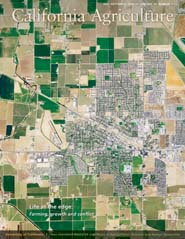All Issues

Life at the edge: Farming, growth and conflict
Cover:
The edges of Los Banos, a city of more than 30,000 in Merced County, are irregular, creating more opportunities for urban-agricultural conflict (pages 121, 127). Geographic information systems (GIS) are being used to more accurately assess land use, aiding in regional planning and farmland conservation (pages 118, 129).
July-September 2010
Volume 64, Number 3
Volume 64, Number 3





